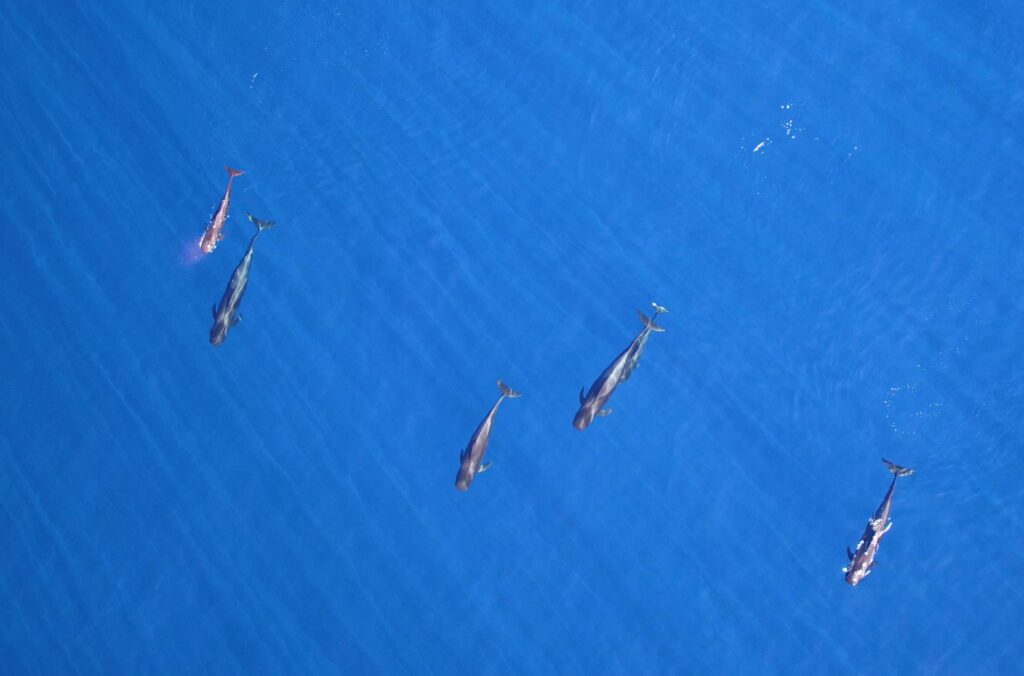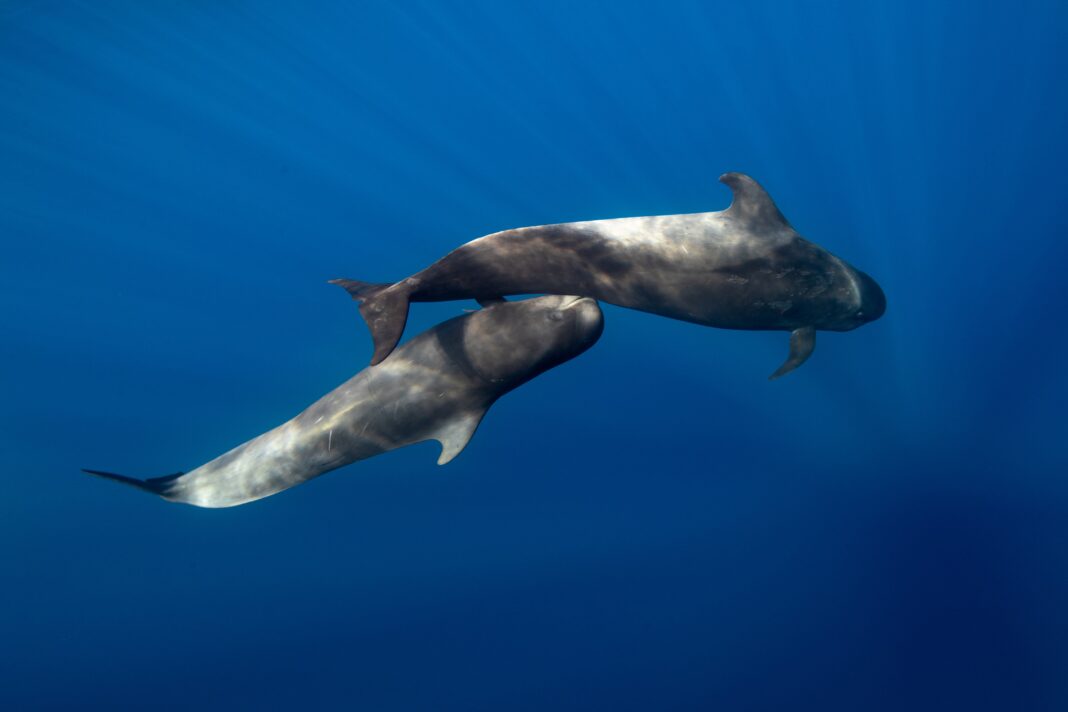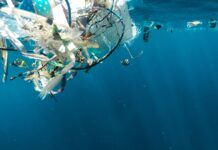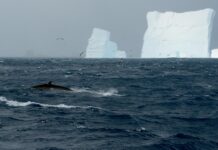The goliath of oceans
Oceans dominate our planet and consist of a complex, mysterious, and dynamic ecosystem. Scientists have identified more than 200,000 marine species, and perhaps millions of species are yet to be documented. Marine organisms vary in size from microscopic phytoplankton to gigantic blue whales.
All whales are classified as cetaceans, from the Latin Cetus (large sea animal) and Greek ketos (sea monster). This scientific order includes dolphins and porpoises as well. Marine biologists estimate more than eighty species of cetaceans living in the oceans. Whales are divided into two types: toothed (Odontocetes) and baleen (Mysticetes). Baleen whale species are generally larger than toothed whales, except for the mighty sperm whale, the largest toothed whale.
Sound is important in cetacean behaviour
We know a great deal about the anatomy and physiology of cetaceans from animals washed ashore or killed by whalers, but little is known about their behaviour. Hearing is the main sensory cue for all cetaceans. Since sound travels faster through water (almost four times faster than through air), whales rely on sound for communication, foraging, mating, sensing predators, and navigating through the contours of the seabed. This is called ‘echolocation’. They make noises that bounce back from nearby objects and alert them of their surroundings. Sound also plays a prominent role in the social behaviour of whales. For instance, most toothed whales are sociable nomads that live a wandering and endlessly mobile life. They migrate in groups through the ocean and sonar communication plays a vital role in this social activity of whales.

From prey to personage
Humans and marine mammals such as whales have a long history of interaction. There are descriptions of whale hunts by the Phoenicians as early as 1,000 B.C. Inuit, Basques, and Japanese have relied on whales to provide food and goods; whales have been part of their cultural identity. Slaughtered for more than six centuries, many species of whales were brought to the verge of extinction. Fortunately, human interest in these marine mammals has shifted to observing, studying, and appreciating than exploiting them.
From myths to literature and arts, whales have played prominent roles in influencing our modern literature. The famous 19th century novel by Herman Melville, Moby Dick, features a great white sperm whale as the main antagonist. Other literary additions that centre on whales include Rudyard Kipling’s Just So Stories (1902) and the award-winning children’s book The Snail and the Whale (2003) by Donaldson and Scheffer.
Living alongside men, the interactions between humans and whales have changed. Whales now have become a major tourist magnet all over the world. Watching whales, dolphins, and porpoises in their natural habitat is probably the ultimate wildlife experience. Whale watching is the fastest growing tourist activity in the world. It began in 1955 along the southern coast of California, USA. At present, whale watching is well established across 70 different countries including North America, Canada, Norway, South America, and Japan.
The mass commercialization of this industry is rampant, whereby in 2009, 13 million tourists participated in whale watching tours across 119 countries. The total revenue generated in 2009 reached a staggering amount of USD 2.1 billion! Supporters of whale watching say that it is educational, scientific, recreational, and pleasurable. Nevertheless, we must not overlook the potential adverse effects of whale watching activity on marine mammals.
Alarming anthropogenic noise
The advent of the industrial revolution since the mid-18th century resulted in substantially noisier oceans. Shipping, ocean exploration, oil mining, underwater military activities, and infrastructure development increased anthrophony (sounds generated by human activities). In preindustrial times, the oceans of the world had pristine and well-managed soundscapes (a continuously changing variety of sounds from living organisms, natural processes, and human activities). The increase in man-made noise negatively impacts marine life and has triggered a massive decline in sound-producing animals.
The number of vessels used to watch whales and other types of cetaceans is proportional to the growth of the whale watching industry. The frequency from vessel noise overlaps considerably with the hearing ranges of most marine fauna, especially those sensitive to low frequency ranges such as cetaceans. Previous studies from different parts of the world have shown that an increased presence of whale watching vessels on the ocean surface causes deleterious effects on the longevity of different species of cetaceans. Moreover, anthropogenic noise from whale-watching vessels should be considered for baleen and toothed whales.
Scientists from Australia and New Zealand have identified an overall decrease in the population size of two species of bottlenose dolphins (Tursiops aduncus and T. truncatus). Furthermore, two studies reveal that noise generated by whale watching vessels elicits behavioural responses in killer whales and humpback whales. Humpback whales from the coastal region of Exmouth, Australia, had reduced time spent resting in the vicinity of a loud vessel by 27% compared to an inaudible vessel. At present, there are regulatory guidelines to monitor distance, speed, and angle of approach and the number of vessels permitted for the whale-watching industry. However, there are no regulations or proper guidelines to monitor whale-watch vessel noise levels, although they are the primary cause of behavioural changes in cetaceans.
A joint collaborative scientific effort from Spain, Denmark, and Iceland, led by Dr. Patricia Arranz, has identified behavioural disturbances in short-finned pilot whales (Globicephala macrorhynchus) after exposure to louder petrol engine noise (151–139 dB) from whale-watch vessels. The short-finned pilot whale is widespread and abundant throughout the world’s tropical, subtropical, and warm temperate oceans. These species of cetaceans often engage in a specific resting behaviour called logging, where they lie floating at the surface in the same direction. This particular behaviour could attract whale-watching vessels to approach the animals too close.
Patricia and her team conducted their experiments in a deep-water environment off the Canary Islands. There has been an immense tourism industry since the 90s at the Canary Islands, including whale-watching activities. Whale watching has increased to such a great extent that the Canary Islands are the fourth most common destination for the whale-watching industry. This study, recently published in Nature Scientific Reports, measured behavioural responses of 36 mother-calf short-finned pilot whales. Mothers’ resting and nursing time declined significantly by 29% and 81%, respectively, after exposure to louder whale-watch vessels. These new findings can support the development of best practice guidelines to monitor noise levels on whale-watching vessels.
The future of cetaceans conservation
Centuries ago, there could have been more cetaceans in the oceans than now. Whaling and other forms of human activity have resulted in some species of cetaceans reaching the brink of extinction. Cetaceans are elusive creatures; they spend a significant portion of their life underwater or in remote areas. Hence, they can be extremely difficult to study. Our understanding of these magnificent creatures is incomplete and changing all the time as discoveries are being made. More scientific research, such as those discussed here, is necessary to unveil their behaviour to protect these aquatic mammals from extinction.
Anthropogenic marine noise is typically a point-source pollutant, whereby the effects of noise pollution decline swiftly when sources are removed. Therefore, national and international policies should be more rigorous to mitigate marine noise from whale-watching vessels. Patricia and her team concluded that lower whale-watch vessel noise sustains whale-watching tourism whilst reducing disturbances to cetaceans. Improving human stewardship of ocean soundscape results in a healthy ocean.
References
Arranz, P., Glarou, M., & Sprogis, K. R. (2021). Decreased resting and nursing in short-finned pilot whales when exposed to louder petrol engine noise of a hybrid whale-watch vessel. Scientific Reports, 11(1). https://doi.org/10.1038/s41598-021-00487-0
Au, W. W. L. (1993). The Sonar of Dolphins. Springer.
Carwardine, M. (1995). Whales Dolphins and Porpoises (D.K. Handbooks) (1st ed.). DK (Dorling Kindersley Limited).
Duarte, C. M., Chapuis, L., Collin, S. P., Costa, et al., (2021). The soundscape of the Anthropocene ocean. Science, 371(6529). https://doi.org/10.1126/science.aba4658
Erbe, C. (2002). Underwater Noise Of Whale-Watching Boats And Potential Effects On Killer Whales (Orcinus Orca), Based On An Acoustic Impact Model. Marine Mammal Science, 18(2), 394–418. https://doi.org/10.1111/j.1748-7692.2002.tb01045.x
Hoyt, E. (2018). Tourism. Encyclopedia of Marine Mammals, 1010–1014. https://doi.org/10.1016/b978-0-12-804327-1.00262-4
Lusseau, D., Slooten, L., & Currey, R. J. C. (2006). Unsustainable Dolphin-watching Tourism in Fiordland, New Zealand. Tourism in Marine Environments, 3(2), 173–178. https://doi.org/10.3727/154427306779435184
Monterey Bay Aquarium Research Institute. (n.d.). Ocean Soundscape. MBARI. Retrieved February 14, 2022, from https://www.mbari.org/mars-hydrophone/#:~:text=The%20ocean%20soundscape%20is%20a,construction%2C%20and%20resource%20extraction.
Nature’s Mighty Powers: The Mighty Oceans. (2012). READER’S DIGEST.
Reeves, R. R., Stewart, B. S., Clapham, P. J., & Powell, J. A. (2002). Sea Mammals of the World: A Complete Guide to Whales, Dolphins, Seals, Sea Lions and Sea Cows. Gardners Books.
Sprogis, K. R., Videsen, S., & Madsen, P. T. (2020). Vessel noise levels drive behavioural responses of humpback whales with implications for whale-watching. eLife, 9. https://doi.org/10.7554/elife.56760
Tyack, P. L., & Clark, C. W. (2000). Communication and Acoustic Behavior of Dolphins and Whales. Hearing by Whales and Dolphins, 156–224. https://doi.org/10.1007/978-1-4612-1150-1_4
WWF, Hare, T., & Lambert, M. (1993). Animal World Mammals Their Lives and Their Future: Sperm Whales and Other Toothed Whales (Vol. 28). Marshall Cavendish.





